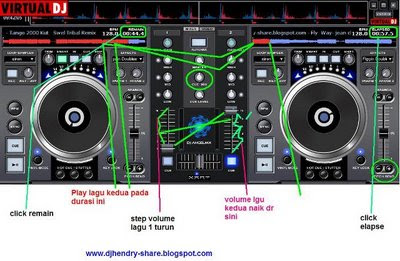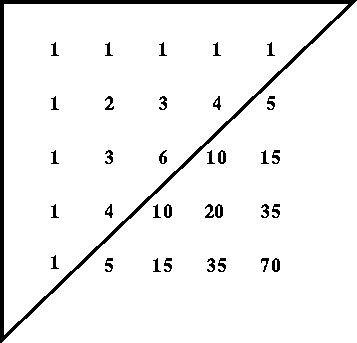Cara membuat lagu dj dan ngeremix
Yup, Ketemu lagi sob di blog dj tempat gw terus belajar , juga sharing
ini setelah beberapa minggu tidak update maklum ada kesibukan sedikit
ngerjain pesanan nge-remix lagu. well, gw pikir poin bagaimana menjadi dj sudah di tulis di article
sebelumnya ya..Silahkan baca di cara menjadi dj jika yang belum baca.
Article kali ini tentang membuat lagu dj dan nge-remix lagu yang
mungkin lo pernah baca di forum-forum diskusi soal musik.
Well, langsung saja kita mulai tentang membuat lagu dj.
Katanya bro seorang dj walaupun sudah bisa mixing atau katakanlah sering perform di club, akan tetapi jika dia belum bisa bikin lagu sendiri, nge-remix atau ngedit/mashup lagu rasanya belumlah Perfect. Karena menurut gw dan teman-teman lainya, perform dengan membawakan lagu buatan sendiri, remixan,edit, rasanya lebih puas ketimbang selalu memainkan lagu orang. Ok..apa saja yang di perlukan untuk membuat lagu dj??
1. Musik Skill
Yang ini sudah tak asing lagi ya, selain memang bakat tentang musik juga dapat kita peroleh dengan belajar pada orang lain yang lebih bisa. Kadang juga belajar sendiri (otodidak), bakat bukan utama yang penting punya kemauan untuk bisa. Setuju?
2. Software
Nah untuk bagian ini silahkan baca di dj software, apa saja sih software yang pake para dj untuk membuat lagu. Kalo gw terus terang Pake Fl-studio (fruityloop) karena dari dulu memang sudah biasa dan cinta banget..hehe. Menurut gw Fl-studio lebih lengkap kalo udah paham. Lihat video cara mengunakan Tool di fl studio untuk pemula tentang gambaran apa aja fungsi komponennya.
3. Gear/Hardware
Ini mencakup peralatan sound sistem yang mendukung dan juga alat musik yang lain. Tapi tidak usah khawatir jaman sekarang makin canggih tanpa alat musik pun kita sudah bisa membuat lagu dj yaitu pake software di tambah vst (virtual studio technologi). Karena yang kita buat adalah jenis music electronik. Jenis music electronic banyak di jual di beatport, junodownload, dan lainnya. Selain jenis music itu mereka tidak jual. Untuk jelasnya tentang jenis music electronic apa saja silahkan ke Tkp tante wiki electronic genre..Nah yang paling sederhana kita hanya butuh tool : Speaker (active/not), Headphone, Amplifier. Itu aja gw rasa dah cukup untuk menghemat cost.
4. Sampler/samples
Sampler biasanya berupa , sound effect, drum loop, midi,single sound (electronik musik instrument). Adanya samples mempermudah kita saat membuat music, artinya kita tidak perlu susah payah membuat beat (making beat) atau sound lainnya.Tetapi sangat di sarankan sebelum ente menggunakan loop samples, lebih baik ente harus bisa membuat basic beat sendiri. Pada setiap software biasanya sudah di sediakan namun kadang cuma samples standar. Seperti di Fl studio, ACid pro, sampler yang di sediakan pun tidak banyak tapi sudah cukup untuk pemula. Untuk ngeremix, ngedit lagu-lagu Dj sebaiknya gunakan samples yang sesuai genre-nya agar lebih mudah.
5. Action
Lakukan proses step by step.
Cara Membuat lagu - lagu DJ
Teori umum : 4 Bar 4 beat.
Yang pertama kita lakukan adalah tentukan dulu genre/style music dj yang akan kita buat. Misalnya genre House music, progressive, trance,breakbeat, tribal house (komersil song). Atau mungkin Funkot. Ketika sudah kita tentukan style musiknya langkah selanjutnya adalah memahami style music itu sendiri. Misalnya standar BPM (beat permenit). Untuk lebih jelasnya soal bpm lihat table di bawah:
Tempo in Bpm
Reggae -----------70–82
Trip Hop --- -----80–92
Hip-hop ----------89–105
Acid Jazz ---------110-116
Disco -------------124-133
Dutch House ------ 126 - 130
House ------------120–128
Break beat n electro 130 –132
Progressive house -------128–135
Tribal -------------130 -135
Trance ------------135–140
Psychedelic --------136--140
Techno ------------140 ke atas
Hardcore ----------150–160
Drum n Bass ------160–170
Tabel ini tidak baku hanya untuk gambaran saja saat lo mau membuat lagu , tapi rata-rata seperti itu jumlahnya. Oh ya bro membuat lagu dan ngeremix/ ngedit itu beda.
Membuat lagu DJ :Sederhananya kalo membuat lagu (composer): Semua aransement musiknya ente yang membuat. Sebagai contoh di bawah ini 2 contoh lagu house buatan Ane dengan konsep lagu simple tune atau minimalis.Bpm 128. Kenapa bpm 128? biar genep and gampang menghitung bar-nya. 4/4.
Well, langsung saja kita mulai tentang membuat lagu dj.
Katanya bro seorang dj walaupun sudah bisa mixing atau katakanlah sering perform di club, akan tetapi jika dia belum bisa bikin lagu sendiri, nge-remix atau ngedit/mashup lagu rasanya belumlah Perfect. Karena menurut gw dan teman-teman lainya, perform dengan membawakan lagu buatan sendiri, remixan,edit, rasanya lebih puas ketimbang selalu memainkan lagu orang. Ok..apa saja yang di perlukan untuk membuat lagu dj??
1. Musik Skill
Yang ini sudah tak asing lagi ya, selain memang bakat tentang musik juga dapat kita peroleh dengan belajar pada orang lain yang lebih bisa. Kadang juga belajar sendiri (otodidak), bakat bukan utama yang penting punya kemauan untuk bisa. Setuju?
2. Software
Nah untuk bagian ini silahkan baca di dj software, apa saja sih software yang pake para dj untuk membuat lagu. Kalo gw terus terang Pake Fl-studio (fruityloop) karena dari dulu memang sudah biasa dan cinta banget..hehe. Menurut gw Fl-studio lebih lengkap kalo udah paham. Lihat video cara mengunakan Tool di fl studio untuk pemula tentang gambaran apa aja fungsi komponennya.
3. Gear/Hardware
Ini mencakup peralatan sound sistem yang mendukung dan juga alat musik yang lain. Tapi tidak usah khawatir jaman sekarang makin canggih tanpa alat musik pun kita sudah bisa membuat lagu dj yaitu pake software di tambah vst (virtual studio technologi). Karena yang kita buat adalah jenis music electronik. Jenis music electronic banyak di jual di beatport, junodownload, dan lainnya. Selain jenis music itu mereka tidak jual. Untuk jelasnya tentang jenis music electronic apa saja silahkan ke Tkp tante wiki electronic genre..Nah yang paling sederhana kita hanya butuh tool : Speaker (active/not), Headphone, Amplifier. Itu aja gw rasa dah cukup untuk menghemat cost.
4. Sampler/samples
Sampler biasanya berupa , sound effect, drum loop, midi,single sound (electronik musik instrument). Adanya samples mempermudah kita saat membuat music, artinya kita tidak perlu susah payah membuat beat (making beat) atau sound lainnya.Tetapi sangat di sarankan sebelum ente menggunakan loop samples, lebih baik ente harus bisa membuat basic beat sendiri. Pada setiap software biasanya sudah di sediakan namun kadang cuma samples standar. Seperti di Fl studio, ACid pro, sampler yang di sediakan pun tidak banyak tapi sudah cukup untuk pemula. Untuk ngeremix, ngedit lagu-lagu Dj sebaiknya gunakan samples yang sesuai genre-nya agar lebih mudah.
5. Action
Lakukan proses step by step.
Cara Membuat lagu - lagu DJ
Teori umum : 4 Bar 4 beat.
Yang pertama kita lakukan adalah tentukan dulu genre/style music dj yang akan kita buat. Misalnya genre House music, progressive, trance,breakbeat, tribal house (komersil song). Atau mungkin Funkot. Ketika sudah kita tentukan style musiknya langkah selanjutnya adalah memahami style music itu sendiri. Misalnya standar BPM (beat permenit). Untuk lebih jelasnya soal bpm lihat table di bawah:
Tempo in Bpm
Reggae -----------70–82
Trip Hop --- -----80–92
Hip-hop ----------89–105
Acid Jazz ---------110-116
Disco -------------124-133
Dutch House ------ 126 - 130
House ------------120–128
Break beat n electro 130 –132
Progressive house -------128–135
Tribal -------------130 -135
Trance ------------135–140
Psychedelic --------136--140
Techno ------------140 ke atas
Hardcore ----------150–160
Drum n Bass ------160–170
Tabel ini tidak baku hanya untuk gambaran saja saat lo mau membuat lagu , tapi rata-rata seperti itu jumlahnya. Oh ya bro membuat lagu dan ngeremix/ ngedit itu beda.
Membuat lagu DJ :Sederhananya kalo membuat lagu (composer): Semua aransement musiknya ente yang membuat. Sebagai contoh di bawah ini 2 contoh lagu house buatan Ane dengan konsep lagu simple tune atau minimalis.Bpm 128. Kenapa bpm 128? biar genep and gampang menghitung bar-nya. 4/4.
SelengkapNya: http://www.djhendryal.com/2010/07/cara-membuat-lagu-dj-dan-ngeremix.html#ixzz2BUlRKTaq
belajar menjadi dj, ngeremix lagu, tutorial Fl studio, virtualdj tutorial, lagu dj, Funkot, jual cdj
Under Creative Commons License: Attribution Non-Commercial Share Alike


















 .
Pascal used the triangle partly for this purpose,
and partly to find the numbers of combinations of m things taken
n at a time, which he stated, correctly, to be
(n+1)(n+2)(n+3) ... m / (m-n)!
.
Pascal used the triangle partly for this purpose,
and partly to find the numbers of combinations of m things taken
n at a time, which he stated, correctly, to be
(n+1)(n+2)(n+3) ... m / (m-n)!
 ,
,
 ,
and
,
and
 ,
one limit being either 0 or
,
one limit being either 0 or
 .
He also investigated the geometry of the Archimedean spiral. These
researches, according to D'Alembert, form a connecting link between
the geometry of Archimedes and the infinitesimal calculus of Newton.
.
He also investigated the geometry of the Archimedean spiral. These
researches, according to D'Alembert, form a connecting link between
the geometry of Archimedes and the infinitesimal calculus of Newton.